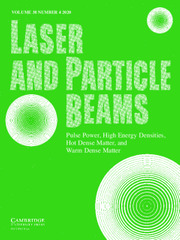Crossref Citations
This article has been cited by the following publications. This list is generated based on data provided by
Crossref.
Limpouch, J
Demchenko, N N
Gus'kov, S Yu
Kálal, M
Kasperczuk, A
Kondrashov, V N
Krouský, E
Ma ek, K
Pisarczyk, P
Pisarczyk, T
and
Rozanov, V B
2004.
Laser interactions with plastic foam—metallic foil layered targets.
Plasma Physics and Controlled Fusion,
Vol. 46,
Issue. 12,
p.
1831.
Gus’kov, S. Yu.
2005.
Hydrodynamic and Kinetic Model of Laser-Stimulated Homogenization of Volume-Structured Media.
Journal of Russian Laser Research,
Vol. 26,
Issue. 4,
p.
312.
LIMPOUCH, J.
DEMCHENKO, N.N.
GUS'KOV, S.YU.
GROMOV, A.I.
KALAL, M.
KASPERCZUK, A.
KONDRASHOV, V.N.
KROUSKY, E.
MASEK, K.
PFEIFER, M.
PISARCZYK, P.
PISARCZYK, T.
ROHLENA, K.
ROZANOV, V.B.
SINOR, M.
and
ULLSCHMIED, J.
2005.
Laser interactions with low-density plastic foams.
Laser and Particle Beams,
Vol. 23,
Issue. 3,
p.
321.
Gus’kov, Sergey Yu.
2010.
Nonequilibrium laser-produced plasma of volume-structured media and inertial-confined-fusion applications.
Journal of Russian Laser Research,
Vol. 31,
Issue. 6,
p.
574.
Gus’kov, S. Yu.
Limpouch, J.
Nicolaï, Ph.
and
Tikhonchuk, V. T.
2011.
Laser-supported ionization wave in under-dense gases and foams.
Physics of Plasmas,
Vol. 18,
Issue. 10,
De Angelis, R
Andreoli, P
Consoli, F
Cristofari, G
and
Di Giorgio, G
2014.
Research activity in the laboratory for inertial confinement fusion in ENEA – Frascati.
Journal of Physics: Conference Series,
Vol. 508,
Issue. ,
p.
012033.
Gus’kov, S Yu
Cipriani, M
De Angelis, R
Consoli, F
Rupasov, A A
Andreoli, P
Cristofari, G
and
Di Giorgio, G
2015.
Absorption coefficient for nanosecond laser pulse in porous material.
Plasma Physics and Controlled Fusion,
Vol. 57,
Issue. 12,
p.
125004.
De Angelis, R.
Consoli, F.
Gus'kov, S. Yu.
Rupasov, A.A.
Andreoli, P.
Cristofari, G.
Giorgio, G. Di
Giulietti, D.
Cantono, G.
and
Kalal, M.
2016.
Ablation loading of solid target through foam absorber on ABC laser at ENEA-Frascati.
Journal of Physics: Conference Series,
Vol. 688,
Issue. ,
p.
012013.
Velechovsky, J
Limpouch, J
Liska, R
and
Tikhonchuk, V
2016.
Hydrodynamic modeling of laser interaction with micro-structured targets.
Plasma Physics and Controlled Fusion,
Vol. 58,
Issue. 9,
p.
095004.
Cipriani, M.
Gus'kov, S.Yu.
Angelis, R. De
Andreoli, P.
Consoli, F.
Cristofari, G.
Giorgio, G. Di
Ingenito, F.
and
Rupasov, A.A.
2016.
Powerful laser pulse absorption in partly homogenized foam plasma.
Journal of Instrumentation,
Vol. 11,
Issue. 03,
p.
C03062.
Dolgoleva, GV
and
Zykova, A I
2017.
The choice of the energy embedding law in the design of heavy ionic fusion cylindrical targets.
Journal of Physics: Conference Series,
Vol. 894,
Issue. ,
p.
012026.
Cipriani, M.
Gus'kov, S.Yu.
De Angelis, R.
Consoli, F.
Rupasov, A.A.
Andreoli, P.
Cristofari, G.
Di Giorgio, G.
and
Ingenito, F.
2018.
Laser-supported hydrothermal wave in low-dense porous substance.
Laser and Particle Beams,
Vol. 36,
Issue. 1,
p.
121.
Cipriani, M.
Gus'kov, S.Yu.
Consoli, F.
Angelis, R. De
Rupasov, A. A.
Andreoli, P.
Cristofari, G.
and
Giorgio, G. Di
2020.
Hydrodynamics and transport processes in porous materials under terawatt laser irradiation.
Journal of Instrumentation,
Vol. 15,
Issue. 10,
p.
C10003.
Fazeli, Reza
2020.
Efficient absorption of laser light by nano-porous materials with well-controlled structure.
Laser Physics Letters,
Vol. 17,
Issue. 4,
p.
046001.
Blackman, David R
Adak, Amitava
Singh, Prashant K
Lad, Amit D
Chatterjee, Gourab
Ridgers, Christopher P
Del Sorbo, Dario
Trines, Raoul M G M
Robinson, A P L
Nazarov, Wigen
Ravindra Kumar, G
and
Pasley, John
2021.
Formation and evolution of post-solitons following a high intensity laser-plasma interaction with a low-density foam target.
Plasma Physics and Controlled Fusion,
Vol. 63,
Issue. 7,
p.
074001.
Jones, O. S.
Kemp, G. E.
Langer, S. H.
Winjum, B. J.
Berger, R. L.
Oakdale, J. S.
Belyaev, M. A.
Biener, J.
Biener, M. M.
Mariscal, D. A.
Milovich, J. L.
Stadermann, M.
Sterne, P. A.
and
Wilks, S. C.
2021.
Experimental and calculational investigation of laser-heated additive manufactured foams.
Physics of Plasmas,
Vol. 28,
Issue. 2,
Cipriani, M.
Gus’kov, S. Yu.
Consoli, F.
De Angelis, R.
Rupasov, A. A.
Andreoli, P.
Cristofari, G.
Di Giorgio, G.
and
Salvadori, M.
2021.
Time-dependent measurement of high-power laser light reflection by low-Z foam plasma.
High Power Laser Science and Engineering,
Vol. 9,
Issue. ,
Belov, I. A.
Bel’kov, S. A.
Bondarenko, S. V.
Vergunova, G. A.
Voronin, A. Yu.
Garanin, S. G.
Golovkin, S. Yu.
Gus’kov, S. Yu.
Demchenko, N. N.
Derkach, V. N.
Dmitriev, E. O.
Zmitrenko, N. V.
Ilyushechkina, A. V.
Kravchenko, A. G.
Kuz’min, I. V.
Kuchugov, P. A.
Myusova, A. E.
Rogachev, V. G.
Rukavishnikov, A. N.
Solomatina, E. Yu.
Starodubtsev, K. V.
Starodubtsev, P. V.
Chugrov, I. A.
Sharov, O. O.
and
Yakhin, R. A.
2022.
Shock-Wave Pressure Transfer to a Solid Target with Porous Absorber of High-Power Laser Pulse.
Journal of Experimental and Theoretical Physics,
Vol. 134,
Issue. 3,
p.
340.
Gus'kov, S. Yu.
and
Yakhin, R. A.
2023.
Equation of state of a partially homogenized plasma of low-dense porous matter.
Physics of Plasmas,
Vol. 30,
Issue. 6,
Batani, Dimitri
Colaïtis, Arnaud
Consoli, Fabrizio
Danson, Colin N.
Gizzi, Leonida Antonio
Honrubia, Javier
Kühl, Thomas
Le Pape, Sebastien
Miquel, Jean-Luc
Perlado, Jose Manuel
Scott, R. H. H.
Tatarakis, Michael
Tikhonchuk, Vladimir
and
Volpe, Luca
2023.
Future for inertial-fusion energy in Europe: a roadmap.
High Power Laser Science and Engineering,
Vol. 11,
Issue. ,

